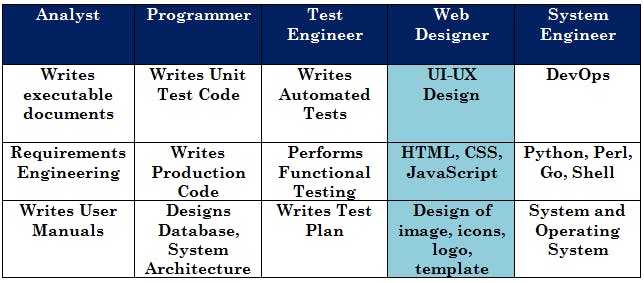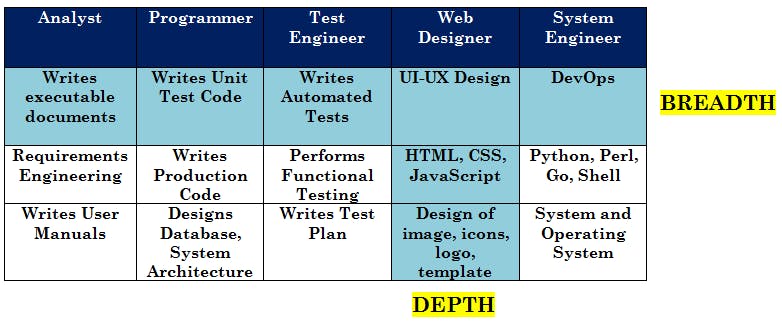Why being a 'T shaped Developer' is better for your development career?
(explained for a T-shaped front end developer) The blog is part of the "Frontend Development" track of DevsInTech Blogs and #2Articles1Week Challenge.
Welcome to this blog on "Why being a 'T shaped Developer' is better for your development career?". To those who might not have heard of the term "T-shaped" developer before, this term might sound a jargon. But worry not, as we are going to break it down into pieces below! First, let's understand who I-shaped developers are to get to understand T-shaped developers.
I-shaped developers
The major domain of jobs available in an organization can be broadly categorized into five, namely,
An Analyst
A Programmer (a part of back-end development)
A Test Engineer (a part of back-end development)
Web designer (a part of front-end development)
System Engineer
We might have heard from various sources that any organization prefers employees who are well-versed in their assigned job and exhibit good productivity in their domain of job. This was (and sometimes is) applicable to tech jobs as well. Developers who are specialists in their specific areas of expertise are generally preferred by organizations. Their areas of expertise may comprise a wide variety of skills but the job they perform may fall into one of the five categories described above.
These types of developers are called I-shaped developers. They are called so as their skill sets look in the shape of the letter I. For eg, a front-end developer (or) a web designer has a list of skills like UI-UX Design, knowledge of HTML, CSS, JavaScript and design of images, icons, logos, templates etc. These skills look in the shape of "I" as shown below.

These "I-shaped" developers are more common in the industry and have a pretty strict skill set. Just like how a backend developer does not know how to make eye-catchy UI designs, a frontend developer cannot do a cloud deployment. In other words, their scope of influence is restricted within their domain. There is absolutely nothing wrong with this but let's take a look at who are T-shaped developers before looking further into this discussion.
T-shaped developers
Just like how an "I-shaped" developer's skillset looked in the shape of an "I", a "T-shaped" developer's skillset will look in the shape of a "T". As simple as that!
A T-shaped developer has a broad knowledge in other areas of expertise besides having a deep area of expertise in their field. For example, a web developer knows how to efficiently perform front-end development tasks and in addition to that, they have sufficient knowledge of the jobs of an analyst, programmer, test engineer and Systems Engineer. Their purview of knowledge also expands to writing basic requirements for the project, creating unit tests, performing basic DevOps operations etc as shown below,

Thus the depth of the developer's skills lies as a web designer and the breadth of their skill ranges across everything that they need to know to perform the job assigned. Since the shape of the developer's skills resembles a "T", they are called as T-shaped developers.
Why do companies prefer T-shaped developers?
They can help everywhere: A T-Shaped developer can contribute to every part of a project. They are very useful in agile teams which manage the project as a whole.
They better understand other developers: Since T-shaped developers have a broad skill set, they know the basics of each area and can interact better with other developers. They know how to ask what they want, understand the difficulty of their tasks and know what to expect from them.
They are open-minded: They are always ready to learn new skills outside of their area of expertise which helps them to keep up with the ever-changing technologies.
They are more rounded developers: T-Shaped developers have a specialty, let's say front-end development, but they also are comfortable doing other jobs outside their scope as we saw above.
They can cover for other developers in case of emergency: In case of any emergency, a T-shaped developer can cover for other I-shaped developers.
How can you become a T-shaped developer?
If you are a beginner, start by choosing an area of expertise first. If you are good at front-end development, then you are an I-shaped developer in front-end development. Next, try to learn the basics of things outside of front-end development by taking up small projects. Learning from other I-shaped developers by sharing knowledge and getting yourself involved in various communities can also help in quicker learning.
Conclusion
Being a T-Shaped developer is important because you can communicate better with your teammates, understand their needs and how they work, and how you can help each other. This process takes time and curiously learning things outside of your domain can help you in becoming an important part of the organization you work for.
You also become a well-rounded developer who understands every part of the process of a project.
And that's a wrap-up. I hope you have learned something from this blog. If it's helpful to you and your front-end development journey then do like, follow me on Hashnode and Twitter and do subscribe to my Hashnode newsletter so that you don't miss any future posts. Thanks for reading and have a great day!